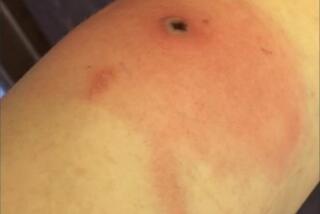Tracking the Course of a Mysterious Disease
- Share via
1732: A fatal nervous disease is noted in sheep and named “scrapie” (pronounced scrape-ee) in England because the affected animals scrape themselves. It is now known to exist throughout most of the world. Only Australia and New Zealand appear to be scrapie-free.
1921-28: German physicians Hans-Gerhard Creutzfeldt and Alfons Maria Jakob independently report a novel fatal neurological condition in people. It becomes known as Creutzfeldt-Jacob disease.
1932: Veterinarians in Toulouse, France, demonstrate that scrapie is infectious by transmitting it by injection.
1947: In Wisconsin, the first of three outbreaks is reported of transmissible mink encephalopathy that will occur in Midwest mink farms.
1950s-present: Scientists in Edinburgh, Scotland, show diseases come in strains. Fingerprinting of the different types begins.
1957: American pediatrician Daniel Carleton Gajdusek publicizes a mysterious disease called kuru, meaning tremble, in a tribe in Papua New Guinea.
1968: Gajdusek’s group at the National Institutes of Health in Bethesda, Md., demonstrate that Creutzfeldt-Jacob disease, like kuru, is a transmissible spongiform encephalopathies, or spongy-brain disease.
1979: Chronic wasting disease, a syndrome observed in captive deer and elk in Wyoming and Colorado, is shown to be a spongy-brain disease.
1984: At a dairy farm in Sussex, England, the first case of suspected sheep scrapie in cattle is reported.
1985: The last U.S. outbreak in mink. Its origins may be fallen livestock. This sets University of Wisconsin veterinarian Richard Marsh on a campaign for the removal of meat and bone meal in U.S. cattle rations.
1986-88: In Sussex, England, cattle disease is found to be a new strain of spongy-brain disease that leaves gross brain damage and is not like any known strain of sheep scrapie. Scientists in Edinburgh later test chronic wasting disease, the U.S. mink spongy-brain disease and sporadic Creutzfeldt-Jakob disease and find them all to be distinct, different strains than mad cow disease.
1989: In Oxford, England, a scientific panel on mad cow disease speculates that if it does affect humans, it will take the form of a novel strain of Creutzfeldt-Jakob disease.
1990: Max, a 5-year-old Siamese cat in Bristol, England, is the first victim of feline spongiform encephalopathy.
1991: In London, the first case of cows infected with mad cow disease, born after the feed ban, are announced. Epidemiologists discover leaks at feed mills of meat and bone meal.
1996: Neuropathologists at Western General Hospital in Edinburgh spot the first 10 cases of a suspicious “new variant” of Creutzfeldt-Jakob disease. The mad cow crisis follows.
1997: The U.S. Food and Drug Administration bans inclusion of meat and bone meal in food for goats, sheep and cattle.
1999: The FDA bans blood donations from people who resided continuously in the United Kingdom for more than six months between 1980 and 1996.
2000: Confirmed cases of mad cow disease: Britain, more than 180,000; Ireland, 487; Portugal, 446; Switzerland, 363; France, 160; Belgium, 18; the Netherlands, six, with others reported in Liechtenstein, Denmark, Luxembourg, Germany and Spain.
2001: The FDA publishes a report criticizing incomplete safety compliance by U.S. feed mills in segregating meat and bone meal from cattle feed. It then quarantines a Texas herd exposed to illegal feed.






